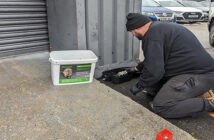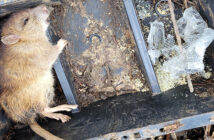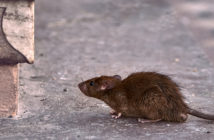On 8 September the Chemicals Regulation Directorate (CRD) published a document outlining the procedure which pest control companies and local authorities would need to follow when applying for use in and around buildings of anticoagulant rodenticides that, up until now, are restricted to indoor use only.
This is good news for the pest control industry – who should, to a large extent, acknowledge the hard work and lobbying activities undertaken by the Rodenticide Resistance Action Group (RRAG). Having said this, the proposed procedures are very detailed and more akin to a ”scientific experiment” than a practical pest control operation – but they are a start.
|
It has been recorded on several occasions that in some areas of the country many organisations cannot perform their statutory obligations to conduct effective rodent control, so as to protect human health. The reason for this being resistance by the rodents to the existing anticoagulant rodenticides approved for ‘outdoor’ use. To date, with one exception, site-specific applications to relax the restriction for use in and around buildings have been declined. |
|
|
|
As CRD explains within their announcement: “Products containing the rodenticides brodifacoum, flocoumafen and difethialone are currently restricted to indoor use only. This restriction is in place due to the high risk of secondary poisoning of birds and mammals. Resistance in rats to first-generation as well as to those second-generation anticoagulants with unrestricted use has been reported. “Due to the lack of alternative (non-anticoagulant) chemical methods of control as well as practical issues with non-chemical methods, problems have been experienced in controlling some populations of rats. It has been considered that the use of brodifacoum, flocoumafen and difethialone could be used to control populations of rats that have exhibited resistance to other anticoagulants. “The use of brodifacoum, flocoumafen and difethialone to control such populations (where it involved outdoor use) would be against previous recommendations made by the Advisory Committee on Pesticides (ACP), therefore CRD has developed a procedure in conjunction with the ACP that applicants should consider prior to making an application.” To read these procedures click here. Commenting on this development, Dr Alan Buckle, chairman of RRAG said: “RRAG welcomes this new procedure which we first proposed at a RRAG seminar in November last year. For the first time in the UK, pest control technicians and local authorities will be allowed to use resistance-breaking rodenticides to control resistant rat infestations. RRAG believes that this will greatly benefit public health and animal hygiene in the increasing areas where resistance is a problem. Effective resistance management will also help prolong the valuable lives of all anticoagulants. Equally importantly, it will benefit the environment because we think it is better to use small quantities of effective rodenticides than apply large quantities of ineffective ones. “However, the procedure must operate cost-effectively. Each application to the Health & Safety Executive (HSE) is made by a rodenticide approval holder on behalf of the pest control company, or local authority, which will eventually carry out the rodenticide treatment. The costs, both financial and in effort to get through red tape, will be borne by the approval holder and must be proportionate. If not, the scheme will be seen by some as an attempt by regulators to appear to do something constructive, when in reality nothing changes. “It is early days and we hope HSE will operate the new procedure efficiently for the benefit of effective rat control. “Finally, although the HSE procedure speaks of ”outdoor” use, RRAG does not support any use of brodifacoum, flocoumafen and difethialone that is not in line with the European Commission’s definition of use ”in and around buildings”. It is also highly unlikely that any approval holder would allow ”outdoor” applications because only uses ”in and around buildings” and in ”sewers” were supported under the Biocidal Products Directive,” concludes Dr Buckle. |
||




